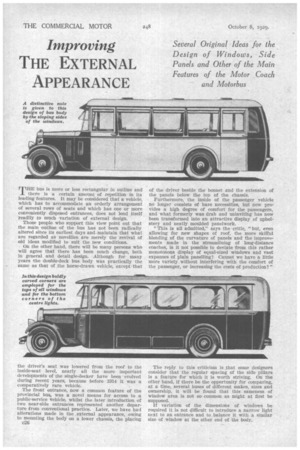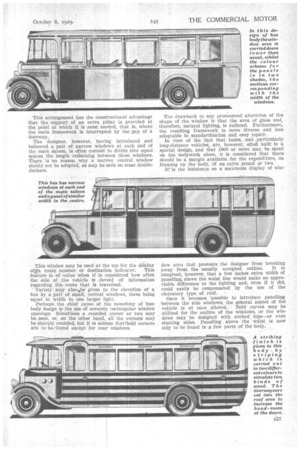Improving THE EXTERNAL APPEARANCE
Page 64

Page 65

Page 66

If you've noticed an error in this article please click here to report it so we can fix it.
Several Original Ideas for the Design of Windows, Side Panels and Other of the Main Features of the Motor Coach and Motorbus
TBE bus is more or less rectangular in outline and there is a certain amount of repetition in its leading features. It may be considered that a vehicle, which has to accommodate an orderly arrangement of several rows of seats and which has one or more conveniently disposed entrances, does not lend itself readily to much variation of external design.
Those people who support this view point out that the main outline of the bus has not been radically altered since its earliest days and-maintain that what are regarded as novelties are merely the revival of old ideas modified to suit the new conditions.
On the other hand, there will be many persons who will agree that there has been much change, both in general and detail design. Although for many years the double-deck bus body was practically the same as that of the horse-drawn vehicle, except that the driver's seat was lowered from the roof to the inside-seat level, nearly all the more important developments of the single-decker have been 'evolved during recent years, because before 1914 it was a comparatively rare vehicle.
The front entrance, now a common feature of the provincial bus, was a novel means for access to a public-service vehicle, whilst the later introduction of two near-side entrances represented another departure from conventional practice. Later, we have had alterations made in the external appearance, owing to mounting the body on a lower chassis, the placing c26 of the driver beside the bonnet and the extension of the panels below the top of the chassis.
Furthermore, the inside of the passenger vehicle no longer consists of bare necessities, but now provides a high degree of comfort for the passengers, and what formerly was drab and uninviting has now been transformed into an attractive display of upholstery and neatly moulded panelwork.
"This is all admitted," says the •critic, "but, even allowing for new shapes of roof, the more skilful blending of the curvature of panels and the improvements made in the streamlining of long-distance coaches, is it not possible to deviate from this rather monotonous display of equal-sized windows and vast expanses of plain panelling? Cannot we have a little more variety without interfering with the comfort of the passenger, or increasing the costs of production?"
The reply to this criticism is that some designers consider that the regular spacing of the side pillars is a feature for which it is worth striving. On the other hand, if there be the opportunity for comparing, at a time, several buses of different makes, sizes and ownership, it will be found that this sameness of window area is not socommon as might at first be supposed.
If variation of the dimensions of windows be required it is not difficult to introduce a narrow light next to an entrance and to balance it with a similar size of window at the other end of the body.
This arrangement has the constructional advantage that the support of an extra pillar is provided at the point at which it is most needed, that is, where• the main framework is interrupted by the gap of a doorway.
The designer, however, having introduced and balanced a pair of narrow windows at each end of the main saloon, is often content to divide into equal spaces the length rethaining between these windows. There is no reason why a narrow central window should not be adopted, as may be seen on some doubledeckers.
This window may be used at the top for the diSplay
ofga route number or destination indicator. This feature is of value when it is considered how often the side of the vehicle is devoid of information regarding the route that is traversed.
' Variety may alsoi4be 'given to the elevation of' a bus by a pair of small,, central windows, these being equal in width to one larger light. Perhaps the chief cause of the monotony of busbody ,design is the use Of severely rectangular window openings: Sometimes a rounded corner or two may be. seen, or, on the other hand, all the corners May be sharply rounded, but it is seldom thattbold corners are tobe?found except for rear windows.
The drawback to any pronounced alteration of the shape of the window is that the area of glass and, therefore, natural lighting, is reduced. Furthermore, the resulting framework is more diverse and less adaptable to standardization and easy repair.
In view of the fact that buses, and ,particularly long-distance vehicles, are, however, often built to a special design, and that £600 or more may be spent on the bodywork alone, it is considered that there should be a margin available for the expenditure, on framing up the 'bodY, of an extra pound or two.
It' is the insistence on a maximum display of win dow area that prevents the designer from breaking away from. the usually, accepted outline. It is imagined, however, that a few inches extra width of panelling, above the waist line would make no appreciable difference to the lighting and, even if it did, could easily be compensated by the use of the clerestory type of roof. •
Once it 'becomes "possible to introduce panelling .between the side windows, the general aspect of the vehicle is at once altered.' Bold curves may be utilized for the outline of the windows, or the windows may be designed with arched tops—or even slanting sides. Panelling above the waist is now only to be found in a few parts of the body. The belt panel has always been a useful factor in the exterior decorative scheme. Sometimes it has curved ends at the point at which the lower moulding joins the upper one but it could also be varied by making it wider under the central windows. However, it is considered that the side of the bus would often be improved, as well as given a fresh appearance, if the belt panel were omitted and the windows made deeper, so -as to include the usual belt-panel area.
Although a lavish display of mouldings is undesirable, the large side panels might be divided by one or more vertical mouldings. If panels were used between the side windows, this width of panel could be extended downward by a pair of mouldings and, if required, the intervening panel could be painted a different colour.
The arrangement of the areas of different colours need not depend upon the setting out of the framework or mouldings, but may be independent of them.
An original design for a central-entrance singledecker was shown at the most recent exhibition of competition drawings, held at the Regent Street Polytechnic. This pattern of bus had semi-circular windows, alternating with smaller ones having semicircular tops. The ventilating lights above these windows were designed to match, so also were the windows of the driver's cab. The back of the body was flat and the opening roof consisted of a series of steps telescoping into one another.




























































































































